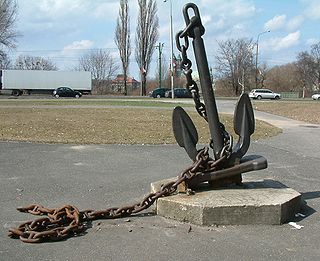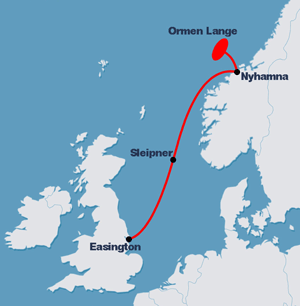A motion compensator is a device that decreases the undesirable effects of the relative motion between two connected objects.
A motion compensator is a device that decreases the undesirable effects of the relative motion between two connected objects.
A motion compensator is a device that decreases the undesirable effects of the relative motion between two connected objects. The motion compensator does not prevent the motion, but tries to eliminate the negative effects of the movement. These negative effects include (1) the changes in force and stresses, and (2) the hysteresis, i.e., the rapid start-and-stop "jerking" of the objects.
Motion compensators are usually placed between a floating object and a more stationary object, such as a vessel or a structure fixed to the seabed. Most general motion compensators will compensate for movement in all directions
The simplest motion compensator is the anchor chain of a ship. Not only does the anchor prevent the ship from drifting, but the chain itself dampens the movement of the ship due to undulating motion of the waves. Generally, motion compensators are implemented as springs. For very large forces (dozens to hundreds of tonnes), the springs are implemented as gas springs: hydropneumatic devices — a plunger cylinder buffered by a volume of gas.
A heave compensator is a kind of motion compensator that compensates for movement in only one direction.
Examples of heave compensators include:

An anchor is a device, normally made of metal, used to secure a vessel to the bed of a body of water to prevent the craft from drifting due to wind or current. The word derives from Latin ancora, which itself comes from the Greek ἄγκυρα.

Buoyancy, or upthrust, is an upward force exerted by a fluid that opposes the weight of a partially or fully immersed object. In a column of fluid, pressure increases with depth as a result of the weight of the overlying fluid. Thus the pressure at the bottom of a column of fluid is greater than at the top of the column. Similarly, the pressure at the bottom of an object submerged in a fluid is greater than at the top of the object. The pressure difference results in a net upward force on the object. The magnitude of the force is proportional to the pressure difference, and is equivalent to the weight of the fluid that would otherwise occupy the submerged volume of the object, i.e. the displaced fluid.

A mooring is any permanent structure to which a seaborne vessel may be secured. Examples include quays, wharfs, jetties, piers, anchor buoys, and mooring buoys. A ship is secured to a mooring to forestall free movement of the ship on the water. An anchor mooring fixes a vessel's position relative to a point on the bottom of a waterway without connecting the vessel to shore. As a verb, mooring refers to the act of attaching a vessel to a mooring.

A corona discharge is an electrical discharge caused by the ionization of a fluid such as air surrounding a conductor carrying a high voltage. It represents a local region where the air has undergone electrical breakdown and become conductive, allowing charge to continuously leak off the conductor into the air. A corona discharge occurs at locations where the strength of the electric field around a conductor exceeds the dielectric strength of the air. It is often seen as a bluish glow in the air adjacent to pointed metal conductors carrying high voltages, and emits light by the same mechanism as a gas discharge lamp. Corona discharges can also happen in weather, such as thunderstorms, where objects like ship masts or airplane wings have a charge significantly different from the air around them.

An accelerometer is a tool that measures proper acceleration. Proper acceleration is the acceleration of a body in its own instantaneous rest frame; this is different from coordinate acceleration, which is acceleration in a fixed coordinate system. For example, an accelerometer at rest on the surface of the Earth will measure an acceleration due to Earth's gravity, straight upwards of g ≈ 9.81 m/s2. By contrast, accelerometers in free fall will measure zero.
Diving physics, or the physics of underwater diving is the basic aspects of physics which describe the effects of the underwater environment on the underwater diver and their equipment, and the effects of blending, compressing, and storing breathing gas mixtures, and supplying them for use at ambient pressure. These effects are mostly consequences of immersion in water, the hydrostatic pressure of depth and the effects of pressure and temperature on breathing gases. An understanding of the physics is useful when considering the physiological effects of diving, breathing gas planning and management, diver buoyancy control and trim, and the hazards and risks of diving.

A diving shot line, shot line, or diving shot, a type of downline or descending line, is an item of diving equipment consisting of a ballast weight, a line and a buoy. The weight is dropped on the dive site. The line connects the weight and the buoy and is used by divers to as a visual and tactile reference to move between the surface and the dive site more safely and more easily, and as a controlled position for in-water staged decompression stops. It may also be used to physically control rate of descent and ascent, particularly by surface-supplied divers.

A diving bell is a rigid chamber used to transport divers from the surface to depth and back in open water, usually for the purpose of performing underwater work. The most common types are the open-bottomed wet bell and the closed bell, which can maintain an internal pressure greater than the external ambient. Diving bells are usually suspended by a cable, and lifted and lowered by a winch from a surface support platform. Unlike a submersible, the diving bell is not designed to move under the control of its occupants, or to operate independently of its launch and recovery system.
In physics, the degrees of freedom (DOF) of a mechanical system is the number of independent parameters that define its configuration or state. It is important in the analysis of systems of bodies in mechanical engineering, structural engineering, aerospace engineering, robotics, and other fields.

A windlass is a machine used on ships that is used to let-out and heave-up equipment such as a ship's anchor or a fishing trawl. On some ships, it may be located in a specific room called the windlass room.
Vibration isolation is the prevention of transmission of vibration from one component of a system to others parts of the same system, as in buildings or mechanical systems. Vibration is undesirable in many domains, primarily engineered systems and habitable spaces, and methods have been developed to prevent the transfer of vibration to such systems. Vibrations propagate via mechanical waves and certain mechanical linkages conduct vibrations more efficiently than others. Passive vibration isolation makes use of materials and mechanical linkages that absorb and damp these mechanical waves. Active vibration isolation involves sensors and actuators that produce disruptive interference that cancels-out incoming vibration.
A drill string compensator decreases the influence of the heave of a drilling vessel on the drill bit. Drill string compensators are also known under the more general name: heave compensator. Drill string compensators are used onboard drill ships and semi-submersible drill rigs. There are two major types of drill string compensators:

A chain is a serial assembly of connected pieces, called links, typically made of metal, with an overall character similar to that of a rope in that it is flexible and curved in compression but linear, rigid, and load-bearing in tension. A chain may consist of two or more links. Chains can be classified by their design, which can be dictated by their use:

A parallel manipulator is a mechanical system that uses several computer-controlled serial chains to support a single platform, or end-effector. Perhaps, the best known parallel manipulator is formed from six linear actuators that support a movable base for devices such as flight simulators. This device is called a Stewart platform or the Gough-Stewart platform in recognition of the engineers who first designed and used them.
Passive heave compensation is a technique used to reduce the influence of waves upon lifting and drilling operations. A simple passive heave compensator (PHC) is a soft spring which utilizes spring isolation to reduce transmissibility to less than 1. PHC differs from AHC by not consuming external power.
A torque amplifier is a mechanical device that amplifies the torque of a rotating shaft without affecting its rotational speed. It is mechanically related to the capstan seen on ships. Its most widely known use is in power steering on automobiles. Another use is on the differential analyser, where it was used to increase the output torque of the otherwise limited ball-and-disk integrator. The term is also applied to some gearboxes used on tractors, although this is unrelated. It differs from a torque converter, in which the rotational speed of the output shaft decreases as the torque increases.
Active heave compensation (AHC) is a technique used on lifting equipment to reduce the influence of waves upon offshore operations. AHC differs from Passive Heave Compensation by having a control system that actively tries to compensate for any movement at a specific point, using power to gain accuracy.

A submarine pipeline is a pipeline that is laid on the seabed or below it inside a trench. In some cases, the pipeline is mostly on-land but in places it crosses water expanses, such as small seas, straits and rivers. Submarine pipelines are used primarily to carry oil or gas, but transportation of water is also important. A distinction is sometimes made between a flowline and a pipeline. The former is an intrafield pipeline, in the sense that it is used to connect subsea wellheads, manifolds and the platform within a particular development field. The latter, sometimes referred to as an export pipeline, is used to bring the resource to shore. Sizeable pipeline construction projects need to take into account many factors, such as the offshore ecology, geohazards and environmental loading – they are often undertaken by multidisciplinary, international teams.
A variable-buoyancy pressure vessel system is a type of rigid buoyancy control device for diving systems that retains a constant volume and varies its density by changing the weight (mass) of the contents, either by moving the ambient fluid into and out of a rigid pressure vessel, or by moving a stored liquid between internal and external variable-volume containers. A pressure vessel is used to withstand the hydrostatic pressure of the underwater environment. A variable-buoyancy pressure vessel can have an internal pressure greater or less than ambient pressure, and the pressure difference can vary from positive to negative within the operational depth range, or remain either positive or negative throughout the pressure range, depending on design choices.
Heave compensation is move compensator technology applied to minimizing the vertical movement of a load supported by lifting gear mounted on a heaving platform. Techniques include active heave compensation and passive heave compensation—the two traditional types of heave compensation—as well as balanced heave compensation. Devices that perform heave compensation are known as heave compensators.